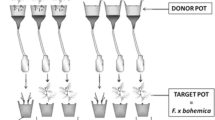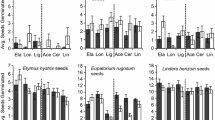Abstract
One theory concerning the invasiveness of exotic plants suggests that they exude phytotoxic compounds that are novel in areas being invaded. For most invasive plants, however, little is known about the effects of their bioactive chemicals and how novel they are in invaded areas. From a methodological point of view, it also remains largely untested whether phytotoxicity found in vitro translates into allelopathic effects in more complex ecological settings. In this study, we tested for allelopathic effects of root exudates of the invasive plant Heracleum mantegazzianum (giant hogweed), its native congener Heracleum sphondylium (common hogweed) and two less-related native species. We also performed chemical analyses of the invader’s root exudates to identify bioactive compounds. We found that root exudates of H. mantegazzianum contain allelopathic compounds which are not likely to be furanocoumarins, but other as yet unidentified molecules. Allelopathy of the invader detected in vitro conditions and in our garden experiment did not, however, differ from the allelopathy of the native species tested. A meta-analysis of two independent garden experiments indicated significantly negative, though similar, phytotoxic effects of H. mantegazzianum, its native congener and Dactylis glomerata in the absence of activated carbon. Our study thus indicates that allelopathy by producing unique compounds, as predicted by the novel weapons hypothesis, is not a principal driver of the invasion success of H. mantegazzianum.






Similar content being viewed by others
References
Abhilasha Quintana DN, Vivanco J, Joshi J (2008) Do allelopathic compounds in invasive Solidago canadensis s.l. restrain the native European flora? J Ecol 96:993–1001
Bais HP, Vepachedu R, Gilroy S, Callaway RM, Vivanco JM (2003) Allelopathy and exotic plants: from genes to invasion. Science 301:1377–1380
Baskin JM, Ludlow CJ, Harris TM, Wolf FT (1967) Psoralen, an inhibitor in the seeds of Psoralea subacaulis (Leguminoseae). Phytochemistry 6:1209–1213
Berenbaum M (1981) Patterns of furanocoumarin distribution and insect herbivory in the umbelliferae—plant chemistry and community structure. Ecology 62:1254–1266. doi:10.2307/1937290
Bertin C, Weston LA, Huang T, Jander G, Owens T, Meinwald J, Schroeder FC (2007) Grass roots chemistry: meta-Tyrosine, an herbicidal nonprotein amino acid. PNAS 104:16964–16969. doi:10.1073/pnas.0707198104
Blair AC, Nissen SJ, Brunk GR, Hufbauer RA (2006) A lack of evidence for an ecological role of the putative allelochemical (±)-catechin in spotted knapweed invasion success. J Chem Ecol 32:2327–2331
Blair AC, Weston LA, Nissen SJ, Brunk GR, Hufbauer RA (2009) The importance of analytical techniques in allelopathy studies with the reported allelochemical catechin as an example. Biol Invasions 11:325–332
Blossey B, Notzgold R (1995) Evolution of increased competitive ability in invasive non-indigenous plants: a hypothesis. J Ecol 83:887–889
Borenstein M, Hedges LV, Higgins JPT, Rothstein HR (2009) Introduction to meta-analysis. Wiley, Chichester
Callaway RM, Aschehoug ET (2000) Invasive plants versus their new and old neighbors: a mechanism for exotic invasion. Science 290:521–523
Callaway RM, Ridenour WM (2004) Novel weapons: invasive success and the evolution of increased competitive ability. Front Ecol Environ 2:436–443
Cappuccino N, Arnason JT (2006) Novel chemistry of invasive exotic plants. Biol Lett 2:189–193
Casinovi CG, Cerrini S, Motl O, Fardella G, Walter F et al (1983) On terpenes 274. The structure of a new sesquiterpene siol acetate from Sium latifolium L. Collect Czech Chem C 48:2411–2422
Catford JA, Jansson R, Nilsson C (2009) Reducing redundancy in invasion ecology by integrating hypotheses into a single theoretical framework. Divers Distrib 15:22–40
Colautti RI, Ricciardi A, Grigorovich IA, MacIsaac HJ (2004) Is invasion success explained by the enemy release hypothesis? Ecol Lett 7:721–733
Crawley MJ (2007) The R Book. Wiley, Chichester
Del Fabbro C, Güsewell S, Prati D (2014) Allelopathic effects of three plant invaders on germination of native species: a field study. Biol Invasions 16:1035–1042
Dostál P (2011) Plant competitive interactions and invasiveness: searching for the effects of phylogenetic relatedness and origin on competition intensity. Am Nat 177:655–667
Dostál P, Müllerová J, Pyšek P, Pergl J, Klinerová T (2013) The impact of an invasive plant changes over time. Ecol Lett 16:1277–1284
Duke SO (2010) Allelopathy: current status of research and future of the discipline: a commentary. Allelopathy J 25:17–29
Eppinga MB, Rietkerk M, Dekker SC, Ruiter PCD, van der Putten WH (2006) Accumulation of local pathogens: a new hypothesis to explain exotic plant invasions. Oikos 114:168–176
Fischer FC, Van Doorne H, Dannenberg G (1978) Glycosides and glycosidase in Heracleum mantegazzianum—their possible role in resistance against fungi. In: Cauwet-Marc AM, Carbonnier J (eds) Actes du 2e Symposium International sur les Ombelliferes. CNRS, Perpignan, pp 783–792
Garcia C, Moyna P, Fernandez G, Heinzen H (2002) Allelopathic activity of Ammi majus L. fruit waxes. Chemoecology 12:107–111
Harborne JB (1971) Flavonoid and phenylpropanoid patterns in the Umbelliferae. Bot J Linnean Soc 64(Suppl. 1):293–314
Hattendorf J, Hansen SO, Nentwig W (2007) Defense system of Heracleum mantegazzianum. In: Pyšek P, Cock MJW, Nentwig W, Ravn HP (eds) Ecology and management of giant hogweed (Heracleum mantegazzianum). CAB International, Wallingford, pp 209–225
Hejda M, Pyšek P, Jarošík V (2009) Impact of invasive plants on the species richness, diversity and composition of invaded communities. J Ecol 97:393–403
Herde A (2005) Untersuchung der Cumarinmuster in Fruchten ausgewahlter Apiaceae. Dissertation, University of Hamburg
Hierro JL, Callaway RM (2003) Allelopathy and exotic plant invasion. Plant Soil 256:29–39
Hoagland DR, Arnon DI (1950) The water-culture method for growing plants without soil. Calif Agric Exp Stn 347:1–32
Inderjit, Nilsen ET (2003) Bioassays and field studies for allelopathy in terrestrial plants: progress and problems. Crit Rev Plant Sci 22:221–238
Inderjit, Seastedt TR, Callaway RM, Pollock JL, Kaur J (2008) Allelopathy and plant invasions: traditional, congeneric, and bio-geographical approaches. Biol Invasions 10:875–890
Ivie GW (1978) Toxicological significance of plant furocoumarins. In: Keeler RF, van Kamper KR, James LF (eds) Effects of poisonous plants on livestock. Academic Press, New York, pp 475–485
Jahodová S, Trybush S, Pyšek P, Wade M, Karp A (2007) Invasive species of Heracleum in Europe: an insight into genetic relationships and invasion history. Divers Distrib 13:99–114
Jain SR (1969) Investigations on essential oil of Heracleum mantegazzianum L. Planta Med 17:230–235
Jandová K, Klinerová T, Müllerová J, Pyšek P, Pergl J, Cajthaml T, Dostál P (2014) Long-term impact of Heracleum mantegazzianum invasion on soil chemical and biological characteristics. Soil Biol Biochem 68:270–278
Joshi J, Vrieling K (2005) The enemy release and EICA hypothesis revisited: incorporating the fundamental difference between specialist and generalist herbivores. Ecol Lett 8:704–714
Junttila O (1975) Allelopathy in Heracleum laciniatum: inhibition of lettuce seed germination and root growth. Physiol Plant 33:22–27
Junttila O (1976) Allelopathic inhibitors in seeds of Heracleum laciniatum. Physiol Plant 36:374–378
Kartesz JT, Meacham CA (1999) Synthesis of the North American Flora, Version 1.0. North Carolina Botanical Garden, Chapel Hill, NC
Kaur H, Kaur R, Kaur S, Baldwin IT, Inderjit (2009) Taking ecological function seriously: soil microbial communities can obviate allelopathic effects of released metabolites. PloS One 4:e4700
Kavli G, Krokan H, Midelfart K, Volden G, Raa J (1983) Extraction, separation, quantification and evaluation of the phototoxic potency of furocoumarins in different parts of Heracleum laciniatum. Photobioch Photobiop 5:159–168
Keane RM, Crawley MJ (2002) Exotic plant invasions and the enemy release hypothesis. Trends Ecol Evol 17:164–170
KNApSAcK (2014) A Comprehensive Species-Metabolite Relationship Database. Version 1.000.01 (2008/06/23). Accessed 28 Apr 2014
Lankau R (2010) Soil microbial communities alter allelopathic competition between Alliaria petiolata and a native species. Biol Invasions 12:2059–2068
Lankau RA, Nuzzo V, Spyreas G, Davis AS (2009) Evolutionary limits ameliorate the negative impact of an invasive plant. PNAS 106:15362–15367
Lind EM, Parker JD (2010) Novel weapons testing: Are invasive plants more chemically defended than native plants? Plos One 5:e10429
Macias FA, Galindo JCG, Massanet GM, Rodriguez-Luis F, Zubia E (1993) Allelochemicals from Pilocarpus goudotianus leaves. J Chem Ecol 19:1371–1379
Miski M, Mabry T (1985) Daucane esters from Ferula communis subsp. communis. Phytochemistry 24:1735–1742
Molho D, Jossang P, Jarreau MC, Carbonnier J (1971) Derives furannocoumariniques du genre Heracleum. Bot J Linnean Soc 64(Suppl. 1):337–360
Müllerová J, Pyšek P, Jarošík V, Pergl J (2005) Aerial photographs as a tool for assessing the regional dynamics of the invasive plant species Heracleum mantegazzianum. J Appl Ecol 42:1042–1053
Myras H, Junttila O (1981) Interaction between Heracleum laciniatum and some other plants. Holarctic Ecol 4:43–48
Nielsen BE (1971) Coumarin patterns in the Umbelliferae. Bot J Linnean Soc 64(Suppl. 1):325–336
Page NA, Wall RE, Darbyshire SJ, Mulligan GA (2006) The biology of invasive alien plants in Canada. 4. Heracleum mantegazzianum Sommier & Levier. Can J Plant Sci 86:569–589
Pandita K, Agarwal SG, Thappa RK, Dhar KL (1984) 1-alpha-acetoxy-6-alpha-hydroxy-9-oxo-carot-2-ene, a new derivative from Sium latijugum seeds. Indian J Chem B 23:956–957
Pergl J, Mullerová J, Perglová I, Herben T, Pyšek P (2011) The role of long-distance seed dispersal in the local population dynamics of an invasive plant species. Divers Distrib 17:725–738
Perglová I, Pergl J, Pyšek P (2006) Flowering phenology and reproductive effort of the invasive alien plant Heracleum mantegazzianum. Preslia 78:265–285
Prati D, Bossdorf O (2004) Allelopathic inhibition of germination by Alliaria petiolata (Brassicaceae). Am J Bot 91:285–288
Pyšek P, Pyšek A (1995) Invasion by Heracleum mantegazzianum in different habitats in the Czech Republic. J Veg Sci 6:711–718
R Development Core Team (2011) R: a language and environment for statistical computing. R Foundation for Statistical Computing, Vienna, Austria
Reaxys database (2014) version 2.15212.2, Elsevier. Accessed 28 Apr 2014
Sheppard AW (1991) Biological flora of the British Isles: Heracleum sphondylium L. J Ecol 79:235–258
Thiele J, Otte A (2007) Impact of Heracleum mantegazzianum on invaded vegetation and human activities. In: Pyšek P, Cock MJW, Nentwig W, Ravn HP (eds) Ecology and management of giant hogweed (Heracleum mantegazzianum). CAB International, Wallingford
Thiele J, Kollmann J, Markussen B, Otte A (2010) Impact assessment revisited: improving the theoretical basis for management of invasive alien species. Biol Invasions 12:2025–2035
Tiley GED, Dodd FS, Wade PM (1996) Heracleum mantegazzianum Sommier et Levier. J Ecol 84:297–319
Viechtbauer W (2010) Conducting meta-analyses in R with the metafor package. J Stat Softw 36:1–48
Wille W, Thiele J, Walker EA, Kollmann J (2013) Limited evidence for allelopathic effects of giant hogweed on germination of native herbs. Seed Sci Res. doi:10.1017/S096025851300007X
Yi T, Zhang L, Fu HW, Yang SL, Tian JK (2009) Two new guaiane sesquiterpenes from the fruits of Daucus carota. Helv Chim Acta 92:2769–2773
Acknowledgments
This study was funded by grant P504/10/0132 from the Czech Science Foundation and grant GAUK512712 from the Charles University Grant Agency. Zdeněk Kameník from the Laboratory for Biology of Secondary Metabolism, Institute of Microbiology, Academy of Sciences of the Czech Republic carried out the LC–MS analyses. Frederick Rooks kindly improved our English. We thank Tereza Klinerová, Zdena Křesinová, Dana Parysová and Daniel Samek for their technical assistance, Lenka Moravcová for her advice during the germination experiments and three anonymous reviewers for their helpful comments on the manuscript.
Author information
Authors and Affiliations
Corresponding author
Rights and permissions
About this article
Cite this article
Jandová, K., Dostál, P. & Cajthaml, T. Searching for Heracleum mantegazzianum allelopathy in vitro and in a garden experiment. Biol Invasions 17, 987–1003 (2015). https://doi.org/10.1007/s10530-014-0771-5
Received:
Accepted:
Published:
Issue Date:
DOI: https://doi.org/10.1007/s10530-014-0771-5




